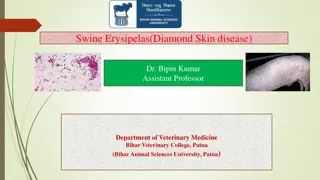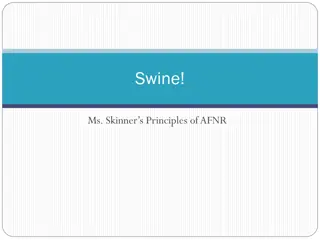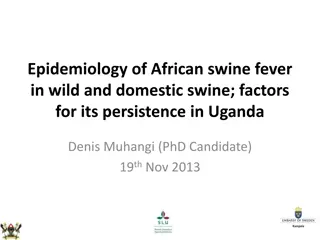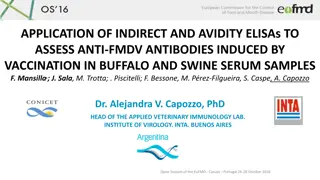New Requirements for PRRS & SECD Testing in Swine
The new rule mandates testing for Porcine Reproductive Respiratory Syndrome (PRRS) and Swine Enteric Corona Virus Disease (SECD) in swine moving into or within Wisconsin, with specific guidelines for testing, movement to exhibitions, and commercial farm scenarios. The rules also outline procedures for swine returning from out-of-state shows and requirements for purchasing swine from auctions or exhibitions.
Uploaded on Oct 03, 2024 | 0 Views
Download Presentation

Please find below an Image/Link to download the presentation.
The content on the website is provided AS IS for your information and personal use only. It may not be sold, licensed, or shared on other websites without obtaining consent from the author.If you encounter any issues during the download, it is possible that the publisher has removed the file from their server.
You are allowed to download the files provided on this website for personal or commercial use, subject to the condition that they are used lawfully. All files are the property of their respective owners.
The content on the website is provided AS IS for your information and personal use only. It may not be sold, licensed, or shared on other websites without obtaining consent from the author.
E N D
Presentation Transcript
PRRS/SECD Rule Change New Rule Requirements for Porcine Reproductive Respiratory Syndrome (PRRS) and Swine Enteric Corona Virus Disease (SECD) Dr. Paul McGraw, State Veterinarian and Division Administrator Wisconsin Department of Agriculture, Trade and Consumer Protection (DATCP), Division of Animal Health
Who has to test? Except swine moving to slaughter or to one exhibition prior to slaughter, the herd of origin of any swine moving into or within Wisconsin must be tested for PRRS/SECD within 90 days of movement. Test samples can be collected by the farm owner under the direction of a veterinarian, but must be submitted through an accredited veterinarian to a diagnostics lab. Test samples can be taken by hanging a cotton rope (from a rope test kit) in a group of pigs to collect saliva. Rope tests are most effective for testing feeder pigs or sows in group housing. The rope test can be used to sample up to 150 swine at one time for both PRRS and SECD. Test samples can also be collected via blood serum and swab by a veterinarian.
When must testing be done for swine on commercial farms? Moving nursery pigs off site. Moving feeder pigs off site to finishing. Importing weaned pigs for finishing. Movement of gilts onto a farrowing farm.
What happens when I go to shows, in state or out of state? Out of State: If exhibition swine originate from Wisconsin and return to Wisconsin after an exhibition or show in another state, the exhibitor must notify DATCP of the movement before returning to Wisconsin. DATCP will quarantine the swine, herd of origin, or both until a herd plan is developed and approved. This provision is not applicable if all the swine at the exhibition or show are from negative herds or the swine returns to Wisconsin to go directly to slaughter.
What happens when I go to shows, in state or out of state? In State: The herd of origin must test negative for PRRS/SECD within 90 days of any swine s movement to the exhibition or show. This allows swine from jackpot shows to have one test early in the spring to travel to a number of shows throughout the season.
What if I buy an animal at an out of state show? Commercial swine purchased or obtained from a commingled auction, sale, show or exhibition must meet all of the following requirements: A report of a negative PRRS and SECD test from the swine s herd of origin conducted within 90 days prior to movement into Wisconsin. A statement from the event s veterinarian that all the swine commingled at the auction, sale, show or exhibition had a negative PRRS and SECD test from their respective herds of origin conducted within 90 days prior to movement to the auction, sale or exhibition. A statement from the event s veterinarian that there are no clinical signs of PRRS or SECD at the time of inspection. If the above cannot be met, swine may be transported to Wisconsin if the person obtains an import permit from DATCP. We will quarantine the swine upon arrival until a herd plan is approved by us.
Positive sites how does that work for selling show pigs? Positive swine will be quarantined on the premises until a herd plan is created by a veterinarian and approved by DATCP.
What is a herd plan? The goal of the herd plan is to bring the herd to negative PRRS and SECD status and limit the spread of the disease. The herd plan must: Be written by a Wisconsin certified, accredited, licensed veterinarian on behalf of the producer. Establish testing protocols relating to PRRS and SECD, as appropriate. Establish notification requirements of at risk farms. Establish biosecurity requirements. Be broken down into separate production categories that need to be managed. Be approved by DATCP. Once a herd plan is approved by DATCP, the quarantine will be lifted. DATCP will provide sample herd plans to assist veterinarians in herd plan development. Scenarios
What is expected at the sale of animals? A swine s herd of origin must test negative for PRRS/SECD not more than 90 days prior to movement from sale. Documentation of the negative tests must be provided upon DATCP request.
When will the proposed requirements become effective? The anticipated effective date of the rule establishing the new testing requirements will be sometime early 2018.

































